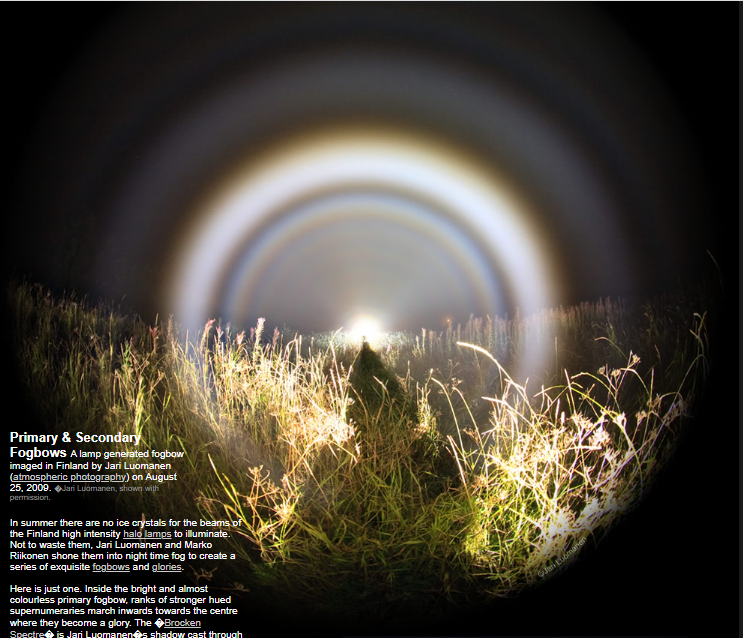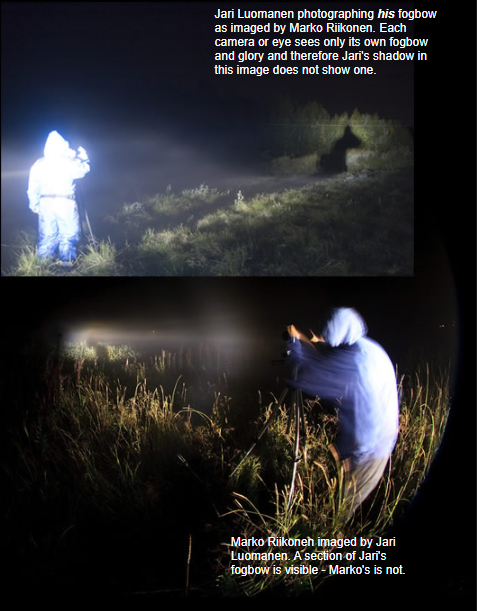Lamps & Fogbows
Lamps & Fogbows: Captivating Phenomena in the Night Sky
When we think of atmospheric optics, we often picture rainbows and halos created by sunlight interacting with ice crystals in the atmosphere. However, there are other fascinating phenomena that can occur when artificial light sources, such as high intensity halo lamps, interact with fog. In this article, we will explore the captivating world of lamps and fogbows and delve into the intricacies of these mesmerizing optical displays.
The Enchanting Primary Fogbow and its Supernumeraries
Imagine a misty night with dense fog enveloping the surroundings. In this ethereal setting, a primary fogbow emerges, characterized by its bright and almost colorless appearance. Within the primary fogbow, a remarkable sight unfolds as ranks of supernumeraries, or additional faint bands of colors, march inward towards the center. As these supernumeraries converge, they transform into a glory, adding a touch of enchantment to the scene.
The Elusive Secondary Fogbow and its Supernumeraries
Beyond the primary fogbow lies a fainter secondary fogbow, a rare sighting indeed. Typically, secondary fogbows are elusive due to their lack of contrast against a bright background. However, in the case of fogbows created by lamps, these secondary bow's supernumeraries become visible. Although faint and diffuse, these secondary supernumeraries add an extra layer of intrigue to the already captivating display.
The Influence of Droplet Size Distribution on Fogbow Appearance
The quality and number of supernumeraries in a fogbow are influenced by the droplet size distribution within the fog. Fog conditions can vary throughout the night, leading to changes in the appearance of the fogbow. Optimal conditions for observing distinct supernumeraries occur when fog droplets are near monosized, meaning they have a similar size distribution. These droplets interact with the lamplight, resulting in the formation of well-defined and vibrant supernumeraries.
The Magic Behind the Fogbow Creation
While magicians keep their tricks hidden, scientists unveil the secrets behind the magic of fogbow creation. To capture the enchanting display, photographers like Jari Luomanen employ high intensity discharge (HID) lamps. These lamps emit a blinding intensity of light that scatters off nearby fog droplets, creating the fogbow. Jari's shadow, cast onto distant trees, adds an intriguing element to the photograph. Interestingly, the glory surrounding the shadow is only visible when looking directly away from the lamp.
The Unique Perspective of Each Observer
It is important to note that each observer, whether using a camera or their own eyes, will perceive their own fogbow and glory. In the case of Jari Luomanen and Marko Riikonen, they captured their respective fogbows while photographing each other. This phenomenon highlights the subjective nature of observing atmospheric optics and adds an element of individuality to these captivating displays.
Embracing the Wonder of Lamps & Fogbows
Lamps and fogbows offer a unique opportunity to appreciate the beauty of atmospheric optics in a different light, quite literally. These captivating displays, created by artificial light sources interacting with fog droplets, provide a mesmerizing spectacle for those fortunate enough to witness them. Whether it's the ethereal primary fogbow with its marching supernumeraries or the elusive secondary fogbow revealing its faint supernumeraries, each experience is a reminder of the awe-inspiring wonders that nature and science can unveil.
In conclusion, lamps and fogbows bring a touch of magic to the night sky. These enchanting optical phenomena offer a glimpse into the intricate interplay between light and atmospheric conditions. From the vibrant supernumeraries within the primary fogbow to the elusive secondary fogbow with its fainter supernumeraries, each sighting is a testament to the captivating beauty of our natural world. So, the next time you find yourself in a foggy night, keep an eye out for the captivating dance of light and mist that is sure to leave you in awe.

Primary & Secondary Fogbows A lamp generated fogbow imaged in Finland by Jari Luomanen (atmospheric photography) on August 25, 2009. �Jari Luomanen, shown with permission.
In summer there are no ice crystals for the beams of the Finland high intensity halo lamps to illuminate. Not to waste them, Jari Luomanen and Marko Riikonen shone them into night time fog to create a series of exquisite fogbows and glories.
Here is just one. Inside the bright and almost colourless primary fogbow, ranks of stronger hued supernumeraries march inwards towards the centre where they become a glory. The �Brocken Spectre� is Jari Luomanen�s shadow cast through the nearby fog as he tends the tripod mounted camera.
Unusually, beyond the primary there is a fainter secondary fogbow and beyond that the secondary bow's supernumeraries. In sun created fogbows the secondary is rarely seen because of lack of contrast with the bright background. Sun generated secondary supernumeraries are a very rare sight on a rainbow and those on a fogbow are too faint and diffuse to compete with daylight.
The quality and number of supernumeraries depends also on the droplet size distribution of the fog. Near monosized droplets are best. Fog conditions changed often during the night vigil.
Magicians conceal their methods while scientists reveal their better magic. At right, a cold insulated Jari is illuminated with blinding intensity by the HID (high intensity discharge) lamp off frame to the left. He points the camera directly away from the lamp to capture the fogbow created by lamplight scattering by nearby fog droplets. The lamp casts his shadow onto distant trees. In this image by Marko Riikonen the shadow has no surrounding glory because that is only seen when looking directly away from the lamp.

Jari Luomanen photographing his fogbow as imaged by Marko Riikonen. Each camera or eye sees only its own fogbow and glory and therefore Jari's shadow in this image does not show one.
Marko Riikonen imaged by Jari Luomanen. A section of Jari's fogbow is visible - Marko's is not.
Note: this article has been automatically converted from the old site and may not appear as intended. You can find the original article here.
Reference Atmospheric Optics
If you use any of the definitions, information, or data presented on Atmospheric Optics, please copy the link or reference below to properly credit us as the reference source. Thank you!
-
<a href="https://atoptics.co.uk/blog/lamps-fogbows/">Lamps & Fogbows</a>
-
"Lamps & Fogbows". Atmospheric Optics. Accessed on November 22, 2024. https://atoptics.co.uk/blog/lamps-fogbows/.
-
"Lamps & Fogbows". Atmospheric Optics, https://atoptics.co.uk/blog/lamps-fogbows/. Accessed 22 November, 2024
-
Lamps & Fogbows. Atmospheric Optics. Retrieved from https://atoptics.co.uk/blog/lamps-fogbows/.